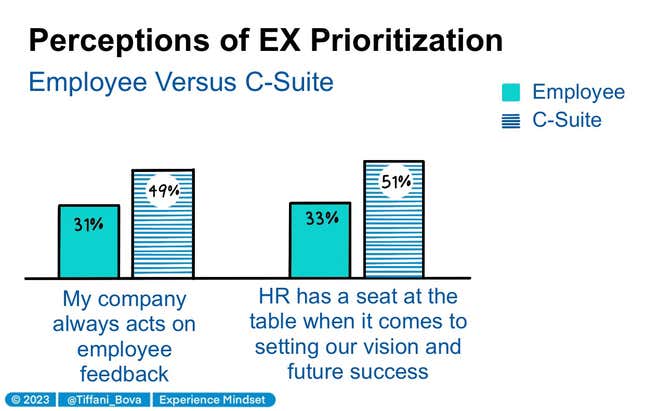
Creating a great customer experience has gained its footing as resources and tools to positively impact those experiences have become more accessible. Unfortunately, the employee experience has been one that’s too often passed to HR to nurture and lacked connection to what the company was doing to grow the customer experience. It’s no wonder, as the gap in c-suite perceptions is large.
Based on exclusive research from two Salesforce studies of thousands of employees and c-suite executives, Tiffani Bova’s book The Experience Mindset: Changing the Way You Think About Growth, explains how an increased focus on EX can magnify company growth many times over. The below book excerpt shares four tactics to improve both CX and EX.
Whether leaders recognize it or not, employees carry the torch every day for the values and mission of their company. They are the facilitators of every moment that matters—the positive connections and negative pain points encountered by a customer or a fellow employee interacting with a brand or an employer.
While many companies are clear on the importance of seamless customer experience and its impact on growth, the role employee experience plays remains overlooked. But in fact, an increased focus on employee experience can increase revenue by more than 50%, and profits by nearly as much. By implementing what I call an “experience mindset,” or focusing on the customer experience (CX) and employee experience (EX) in tandem, companies can achieve a sum greater than its parts, and magnify growth many times over.
C-suite accountability
Lack of c-suite accountability and ownership for EX deepens the c-suite and employee disconnect. For leaders to be accountable, they need to be committed to the business and its people. Leading others isn’t something to take lightly. As the saying goes, people don’t leave bad jobs; they leave bad bosses. Further, they will sometimes leave good jobs and good companies because of poor leadership. And the way a company is managed and led is a direct reflection of its culture.
If you are an executive leader, accountability is part of the job description. Part of being accountable is being willing to ask questions, being open to suggestions, and acting on feedback, particularly concerning the employee experience. Nearly half of C-suite executives (49%) feel that their company excels in acting on employee feedback, compared to just 31% of employees.

4 tactics to improve customer and employee experience
Managers are at a loss about who owns EX. And if nobody owns EX, who will respond to employee feedback? Who will share the lessons learned from employees? Who will advocate for needed changes to EX? There must be direct account- ability or nothing will get done. Establishing this accountability requires a collective effort. Companies should consider implementing one or more of the following tactics:
- Experience advisory board (EAB): An EAB is a group of individuals from different parts of the company, with a preference toward customer- facing employees versus managers or back operations peo- ple. Members of the board are given alternative channels of communication (such as Slack or other collaboration tools) to ensure that ideas, suggestions, and issues that come from the EAB can be easily captured and to allow for further col- laboration outside the board. The idea behind an EAB is to break down the barriers of traditional silos or reporting line systems and brainstorm ideas, ideate, and then feed sugges- tions directly to executive leadership.
- Center of excellence (CoE): A CoE is a team of representa- tives from management, lines of business (LOB), and IT. The CoE provides the organization with best practices around a particular area of interest when there is a knowledge deficit or skills gap. For example, a new CoE may be set up to man- age the adoption and integration of a new CRM system, meet regularly to develop a needs assessment, interview employees who will use the system, and keep communication between groups open. An important goal of a CoE is to eliminate in- efficiency and help achieve excellence.
- Employee resource group (ERG): An ERG is a group of employees who join together in their workplace based on shared characteristics or life experiences. ERGs generally help pro- vide peer-to-peer support, enhance career development, and contribute to personal development in the work environment. ERG members typically have a pulse on what is going on in the business around their specific area and can provide CEOs with an on-the-ground perspective.
- Voice of the employee (VoE): VoE is a structured process in which companies directly solicit and gather employees’ stated needs, wants, expectations, and performance experience about the systems, technology, and processes they have been provided. The voice can be captured via direct observation, surveys, interviews, focus groups, and data, or from in- ternal groups like EABs, CoEs, and ERGs.
Uncovering what employees want and need may seem like a daunting task, but it doesn’t have to be, and it is crucial to developing a supportive culture. Any or all of these groups or processes can provide a more formal and structured way to de- velop greater accountability between the c-suite and employees. Without at least one of these, or a similar group or initiative, you risk losing connection with your employees. When the connection between employees and leadership is lost, so is account- ability.
Aligning employee values and company vision
An engaged workforce is aligned with the values and vision of the organization. The employees are enthusiastic about their work and find purpose and meaning in what they do each day. They care about the future of the organization and are likely to perform better on business-critical key performance indicators such as CX.
Employees want alignment with the company’s values. But in order to achieve this alignment, companies need to spell out the core beliefs guiding the organization. More important, management must live by those values in a visible way. Otherwise, even the best value statements are worthless.
Seventy percent of employees say alignment is the greatest hurdle to achieving company strategy. Your people won’t know what to prioritize or why unless leadership sets clear goals with milestones and assigns success metrics that everyone can align around. Goals connect employees to the company’s mission or vision, and progress toward a meaningful goal is the top motivator for employees.
This is where the c-suite needs to do a better job communicating, not only with direct reports but everyone in the organization. Companies that align employees around long-term goals experience heightened EX and better execution.
Tiffani Bova is the global growth evangelist at Salesforce, a member of the 2021 Thinkers50 global ranking of management thinkers, a former research fellow at Gartner, and the Wall Street Journal bestselling author of the books Growth IQ and The Experience Mindset: Changing the Way You Think About Growth.
Excerpted from The Experience Mindset: Changing the Way You Think About Growth by Tiffani Bova, in agreement with Portfolio, an imprint of Penguin Publishing Group, a division of Penguin Random House LLC. Copyright © Tiffani Bova, 2023.